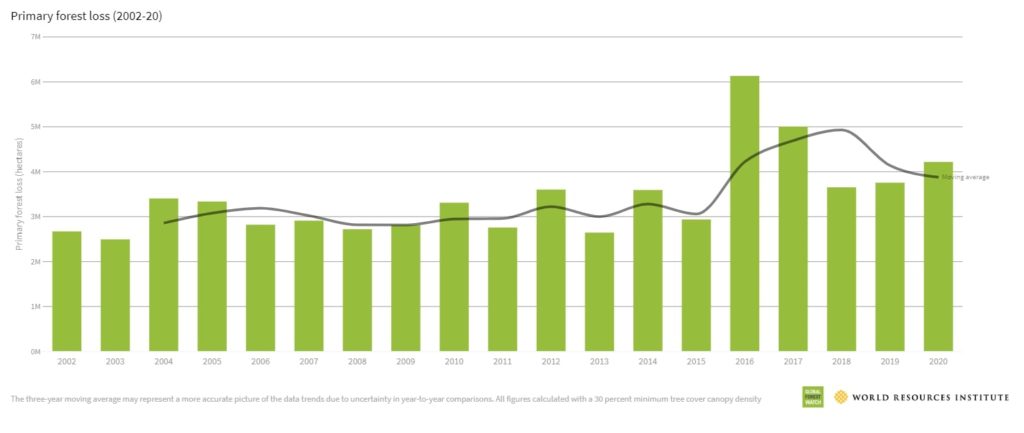Tropical forest loss around the world was 12% higher in 2020 compared to the previous year, despite the drop in demand for deforestation-driving commodities due to COVID-19.
—
4.2 million hectares of primary tropical forest, meaning forest that had lain largely untouched, were lost in 2020. This resulted in a 12% increase from 2019, according to the World Resources Institute, whose subsidiary the Global Forest Watch monitors the state of our forests daily.

Tropical forests are confined to a relatively small land area around the equator, yet they make up 45% of all forest cover and contain 40% of the planet’s total carbon stock. Just last year’s tropical forest loss resulted in around 2.5 billion metric tons of carbon dioxide emissions, slightly less than India’s yearly average.
Historically, the vast majority of this type of deforestation has come from three countries: Brazil, the Democratic Republic of the Congo, and Indonesia. Last year, Brazil remained on top by a wide margin, while Indonesia posted its fourth consecutive year of decline following a catastrophic fire season in 2015. Malaysia also did better, but this was outdone by deforestation spikes in Cameroon and Colombia.
As in previous years, this was driven by conversion for commodity production, like industrial scale agriculture, mining, oil and gas and others. A recent study published in Nature found that rich nations with net reforestation numbers (e.g. China, India, G7 countries) are creating most of the demand. Their actual deforestation footprints have not changed despite domestic declines.
Human-driven deforestation is nothing new, but there is progress in legislation and regulation, so we can hope that things will get much better within the decade. The problem at hand was illustrated by another notable event last year: the Pantanal wetlands wildfires. Climate change has made the region uncharacteristically dry, increasing the likelihood of runaway blazes from slash-and-burn farming.

After Australia’s infamous 2019 fires, it became clear something about our climate was out of whack. Regular reminders have come in the form of the Californian and South American episodes, but there is a lack of accountability, These are essentially treated as freak accidents, and business continues as usual.
These forests aren’t about to disappear, but there is a point where their death will be locked in well before they are entirely cleared. Deforestation feeds climate change through carbon release, which in turn reinforces deforestation and we have no idea where the tipping point lies. Let’s hope that the regulation trend comes back into full swing after COVID-19 dies down.
This article was written by Owen Mulhern.
You might also like: Arctic Lightning Strikes Have Tripled










![The Statistics of Biodiversity Loss [2020 WWF Report]](https://u4d2z7k9.rocketcdn.me/wp-content/uploads/2020/12/lprwinkyTHB-544x306.jpg)





